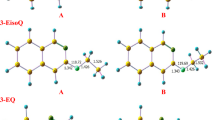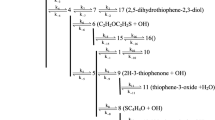Abstract
Bond strengths. The heat of formation of CF2 has been estimated through electron impact, thermochemical and kinetic studies. The most recent measurements were obtained through a study of the pyrolysis of CF2HC1 at 530°–750° C, which is believed1–3 to follow the mechanism:  Either by interpolation from known data, or by assuming the heat of formation of C2F4 (−151.5 kcal/mole (ref. 4) ) and combining this with the thermodynamic data for the equilibrium:
Either by interpolation from known data, or by assuming the heat of formation of C2F4 (−151.5 kcal/mole (ref. 4) ) and combining this with the thermodynamic data for the equilibrium:  it is possible to estimate the heat of formation of CF2HC1 (∼ − 112 kcal/mole); an estimate of the Arrhenius factors of the elementary steps can be derived from the kinetic analysis. Combination of the thermochemical and kinetic data yields ΔHf(CF2) ≲ − 40 kcal/mole, and hence D(F2C−CF2) ≲ 70 kcal/mole. Similar conclusions have been reached by Stull5, on the basis of a study of the formation of C2F4 from carbon and CF4 in a furnace6. Majer and Patrick7 have suggested that higher (less negative) values for ΔHf(CF2), which have been reported on the basis of electron impact studies, result from the production of excited fragments in the primary dissociation.
it is possible to estimate the heat of formation of CF2HC1 (∼ − 112 kcal/mole); an estimate of the Arrhenius factors of the elementary steps can be derived from the kinetic analysis. Combination of the thermochemical and kinetic data yields ΔHf(CF2) ≲ − 40 kcal/mole, and hence D(F2C−CF2) ≲ 70 kcal/mole. Similar conclusions have been reached by Stull5, on the basis of a study of the formation of C2F4 from carbon and CF4 in a furnace6. Majer and Patrick7 have suggested that higher (less negative) values for ΔHf(CF2), which have been reported on the basis of electron impact studies, result from the production of excited fragments in the primary dissociation.
This is a preview of subscription content, access via your institution
Access options
Subscribe to this journal
Receive 51 print issues and online access
$199.00 per year
only $3.90 per issue
Buy this article
- Purchase on Springer Link
- Instant access to full article PDF
Prices may be subject to local taxes which are calculated during checkout
Similar content being viewed by others
References
Hudlicky, M., Chemistry of Organic Fluorine Compounds, 268 (Pergamon Press, London, 1961).
Gozzo, F., and Patrick, C. R., Nature, 202, 80 (1964).
Edwards, J. W., and Small, P. A., Nature, 202, 1329 (1964).
Neugebauer, G. A., and Margrave, J. L., J. Phys. Chem., 60, 1318 (1956).
Stull, D. R., JANAF Thermochemical Tables (1961).
Farlow, M. W., U.S. Patent, 2,709,192 (May 24, 1955).
Majer, J. R., and Patrick, C. R., Nature, 201, 1022 (1964).
Frey, H. M., Progress in Reaction Kinetics, 2, 131 (1964).
Sheppard, N., and Simpson, D. M., Quart. Rev., 6, 1 (1952).
Nielsen, J. D., Claasen, H., and Smith, A., J. Chem. Phys., 18, 812 (1950).
Mann, D. E., and Thrush, B. A., J. Chem. Phys., 33, 1732 (1960).
Simons, J. P., and Yarwood, A. J., Nature, 192, 943 (1961).
Majer, J. R., and Simons, J. P., Advances in Photochemistry, 2, 137 (1964).
Simons, J. P., Cadman, P., and Tatham, P. E. R. (unpublished work).
Atkinson, B., J. Chem. Soc., 2684 (1952).
Fielding, W., and Pritchard, H. O., J. Phys. Chem., 64, 278 (1960).
Merer, A. J., Dis. Faraday Soc., 35, 127 (1963).
Herzberg, G., Proc. Roy. Soc., A, 262, 291 (1961).
Walsh, A. D. (personal communication).
Author information
Authors and Affiliations
Rights and permissions
About this article
Cite this article
SIMONS, J. Chemical Behaviour of Difluorocarbene, and the Dissociation of the Carbon—Carbon Bond in Tetra-fluoroethylene. Nature 205, 1308–1309 (1965). https://doi.org/10.1038/2051308a0
Issue Date:
DOI: https://doi.org/10.1038/2051308a0
Comments
By submitting a comment you agree to abide by our Terms and Community Guidelines. If you find something abusive or that does not comply with our terms or guidelines please flag it as inappropriate.



